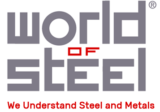Continuous Annealing and Batch Annealing
Continuous and Batch Annealing
Two types of annealing may be used in tinplate manufacture, batch (or box) annealing (BA) or continuous annealing (CA).
A continuous annealing line (CAL) is divided into three parts, an entry section for strip cleaning, a furnace section and an exit section.
The cleaning section contains dip and spray tanks, followed by electrolytic cleaning. The furnace section is split up into a heating section, a soak section and a fast and slow cool section. In each section, a slightly reducing atmosphere is maintained and the strip makes a number of vertical passes through the full height of the furnace. The temperature cycle comprises heating rapidly to about 680°C , holding at temperature for 20-25 seconds, controlled cooling to 480°C and then rapid cooling to room temperature.
To make the steel more ductile for two piece can drawing, the strip is cooled to an overage temperature of between 370 to 400°C and held to allow carbon to precipitate out of solution It is cooled to near room temperature. The precipitation out of carbon softens the steel and makes it more ductile for two piece can manufacture.
Continuous annealing is a constant process without variation. Continuous annealing, by the virtue of the shorter annealing times, produces material with a finer grain size than BA. Therefore the mechanical properties differ for the same Temper number.
In batch annealing, tightly wound coils of cold rolled steel are stacked three or four high on bases with convector spacers between coils. A cover is lowered onto the stack and is sealed at the base. The atmosphere surrounding the coils is purged and replaced with slightly reducing atmosphere. A movable furnace is placed over the entire charge and the coils are heated to the “soaking” temperature, which depends on the steel grade to be made, as does the soak time. After the period at temperature, the furnace cover is removed and the charge is allowed to cool in a controlled manner. A typical batch cycle can range from 10 to 30 hours depending on the steel grade required.
The mechanical properties are better in Continuous Annealing with a higher consistency of physical properties which makes Continuous Annealing suitable in high speed automated lines. However the temper (hardness) is usually on the higher side of the ordered temper tolerance parameters as compared to Batch Annealed.
The lower softness of Batch Annealing gives it better drawing capability and is often preferred in slower lines and for components.
Batch Annealing properties can change from coil to coil as getting the exact same heat treatment in eacho is not possible across the entire ordered quantity.
Tempers T1-T3 are usually batch Annealed. T4 and T5 are usually Continuous Annealed. Double reduced which happens through rolling (and not annealing) can be both batch annealed or Continuous Annealed. Again Batch anneal will be on the lower parameter of the Rockwell tolerance compared to Continuous Annealed.
Some Mills are using ultra low carbon in the chemistry of the materials to get the required softness in the materials and the process is Continuous annealing which combines the consistency and softness required. (Carbon is the main chemical responsible for hardness)
So do you order BA or CA? For some tempers, you don’t have a choice. For others, you may be restricted by the mills ability or inability to supply CA. However for high speed line, you don’t have a choice. Go for CA for the body of the cans and of course check on other parameters of the mills. There are many other parameters that need to be vetted.
So procurement just does not start and end with price. It takes experience and knowledge and sometimes mistakes. This is what we do each day….vetting mills, understanding processes and guiding our customers. Give us a call or email us for your next inquiry.
- Source: The International Tin Association (formerly ITRI Ltd)
